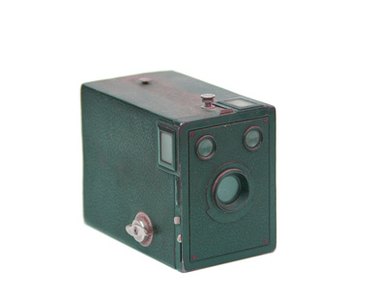
The first permanent photograph was taken in 1826 by a French inventor named Joseph Nicephore Niepce. The black and white exposure took eight hours to burn onto a plate using a camera obscura. The picture is still visible today. By the 1930's cameras were available to the masses and color photography was beginning to be introduced. Cameras were no longer made of wood in the 1930's, with Bakelite and aluminum becoming popular alternatives.
Kodak Box Camera
Video of the Day
Kodak Box cameras of the 1930's were inexpensive and very simple to use. Their name comes from the shape of the camera, most were rectangular and were in a rigid case. The box camera had very few controls, an instant shutter or a timed shutter which stayed open as long as the lever was held down. They had no focus feature and used a roll film. An extra lens was available when a close focus was needed.
Video of the Day
Ensign E20 camera
The Ensign E20 camera was a folding camera that could be folded to fit in the pocket. The Ensar lens fit to the camera giving the camera fine definition. The front lens rotated to aid focusing, the number on the front corresponded to how far away the object of the photo was away from the camera. There were two view finders on the camera, the first for looking at objects at eye level and the second was a waist-level reflecting finder which enabled the user to view the photo from a standing position whilst the camera remained low.
Speed Graphic
The speed graphic was made by Grafle in Rochester, New York and it is commonly known as one of the most famous press cameras. It was a slow camera, after every photo was taken a new film sheet had to be put in the camera, it had to be focused and the shutter needed to be cocked before the next photo could be taken. Photographers had to anticipate when the action would occur to get a good picture. The speed graphic was available in many sizes from 2¼ by 3¼ inch through to the famous 4 by 5 inch camera.
The Kodak Retina I
The Retina was Kodak's first 35mm camera and it pioneered the 135 format of cartridge which is still in use. This cartridge could be loaded into the camera in daylight and made this camera popular with the public as it was also available at an affordable price. The shutter was marked so photos could be taken within a range of 1/500 second and one second. The Retina I could focus pictures as close as 3 feet away and portrait attachments could be added so closer photos could be taken.